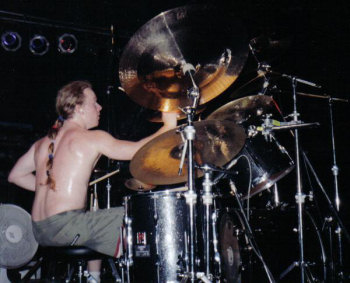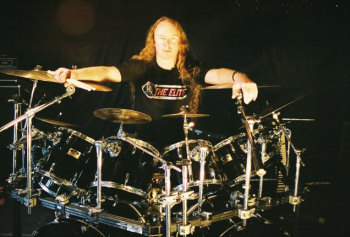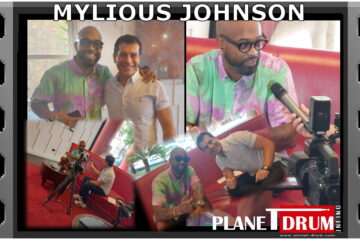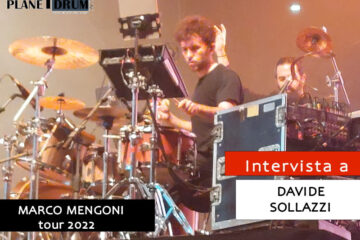RICHARD CHRISTY
Chi di noi non ha mai ascoltato album come “The sound of perseverance”dei Death o “The fragile art of existence”dei Control Denied notandone il drumming notevolmente ricco, creativo ed imponente?
Un pò tutti credo vero ragazzi? Quindi ho pensato che una bella chiacchierata con Richard Christy fosse la cosa migliore da fare e così ecco qua una bella intervista nella quale andremo a scoprire il percorso batteristico,ble opinioni e, soprattutto, l’esperienza vissuta con il compianto Chuck Schuldiner proprio dalle parole dello stesso Richard:

Emiliano Cantiano – Quando hai iniziato a suonare la batteria?
Richard Christy – Quando avevo dieci anni.
EC – Chi sono i batteristi che hanno influenzato il tuo stile?
RC – Ho iniziato a desiderare di suonare la batteria quando ho sentito il drumming della canzone Hot For Teacher di Alex Van Halen. Quella è stata una grande influenza. Più tardi c’è stato Shannon Larkin dei Wrathchild America, Bobby Jarzombek dei Riot, Alex Marquez dei Malevolent Creation.
EC – Con chi hai iniziato a studiare?
RC – Ho studiato a scuola a partire già dalla quinta elementare. Ho suonato nella Marching Band e nella Concert Band. Ho imparato a leggere la musica e poi sono stato autodidatta studiando su libri quali Stick Control di George L. Stone.
EC – Qual è il tuo attuale programma / piano di studi?
RC – Studio ancora sullo Stick Control. Studio anche su un libro della National Association of Rudimental Drumming’s Snare Drum Solos. E amo i video didattici di Terry Bozzio
EC – Che tipo accordatura utilizzi per le pelli?
RC – Mi piace accordare il rullante il più alto e tirato possibile senza arrivare a rompere il fusto, le casse le accordo il più basso possibile, lasciando la pelle molto lenta. La stessa cosa faccio per i tom aumentando gradualmente man mano che raggiungo i tom più piccoli.
EC – Come posizioni il tuo set?
RC – Mi piace tutto molto stretto e vicino e mi piace avere lo stesso setup sia per la destra che per la sinistra, in modo che tutto ciò che si trova sulla sinistra sia esattamente lo stesso alla mia destra.
EC – Che tipo di warm up effettui prima degli spettacoli?
RC – Solitamente utilizzo delle bacchette per marching band molto grandi su un practice pad, faccio anche dei piegamenti sulle braccia e salto con la corda.
EC – Come regoli la molla del pedale?
RC – Stringo le molle il più possibile, mi piace la resistenza che oppongono quando sono più strette.
EC – Quante volte cambi le pelli durante un tour?
RC – Posso cambiare quella del rullante quasi ogni notte, mentre quelle dei tom circa ogni quattro spettacoli, a seconda di quanto tempo e quanto del set suono in quel tour particolare.
EC – Quali sono gli aspetti del tuo drumming che consideri davvero potenti?
RC – Amo il rudimental drumming, quindi credo tutto quello che ho imparato dalle Marching Bands contribuisce più al mio stile. Mi piace prendere i rudimenti del rullante e spostarli su tutta la batteria trasformandoli in battute.
EC – Secondo te, quali sono le qualità che un buon batterista metal deve avere?
RC – Un batterista metal dovrebbe essere in grado di colpire i tamburi in modo molto potente. La batteria suona molto meglio quando è colpita in modo duro piuttosto che leggermente compensando con un’amplificazione massiccia.Anche con i blast beats un batterista metal deve colpire duro.
EC – Dicci qualcosa sulla scena del metal in America: è così diversa da quella europea?
RC – La scena metal è molto meglio in Europa,ci sono molti più festival.
EC – Qual è il tuo pattern preferito (tra quelli che hai registrato) e che suoni più volentieri durante i concerti?
RC – Il mio pezzo di batteria preferito che ho registrato è l’introduzione di Scavenger of Human Sorrow dei Death, sono molto orgoglioso della batteria in quella canzone e di tutto il suono dell’album Perseverance.
EC – Come ti alleni per la sessione in studio di registrazione?
RC – Simile a come mi preparo per un tour. Tonnellate di allenamenti e pratica, due o tre ore al giorno solo io e due ore con la band. Non c’è niente di meglio per una band che suonare insieme.
EC – Dicci com’è stata l’esperienza con Chuck Schuldiner.
RC – Lavorare con Chuck è stato stupefacente. Era la più bella persona che abbia mai incontrato e il musicista di maggior talento che abbia mai incontrato. Eravamo molto amici e io ancora penso a lui ogni giorno. Suonare con i Death era un sogno divenuto realtà per me perché sono stato un fan della musica di Chuck sin da quando ero al liceo.
EC – Insegni?
RC – No, una volta lo facevo, ma ora non più, non ho il tempo purtroppo.
EC – Ti ho visto fare diverse clinics. Quali sono le domande che la gente spesso chiede e qual è il programma delle tue clinics?
RC – Un sacco di fans mi chiedono quale China ho utilizzato nell’album Sound of Perseverance. Beh, è stato un Oriental China Zildjian da 12 pollici e cembalo e un Sabian B8 Pro China Cymbal da 18 pollici.
EC – Quali sono i tuoi album preferiti, quelli che ti hanno fatto innamorare della batteria?
RC – 1984 dei Van Halen, Metal Health dei Quiet Riot, Thundersteel dei Riot, Them dei King Diamond, Climbing the Walls dei Wrathchild America, Retribution dei Malevolent Creation, Human dei Death.
EC – Che strumentazione usi?
RC – Suono anche la chitarra, basso e tastiere. Io uso batterie Pearl, piatti Sabian, bacchette Vater e pelli Acquarian.
EC – Puoi dare un consiglio a tutti quelli che studiano la batteria e che vogliono diventare batteristi metal?
RC – Studiare e suonare molte ore al giorno. Imparare a leggere musica e suonare dietro i vostri album metal preferiti. Mai scoraggiarsi e non mollare mai!
Vi ringrazio molto per l’intervista!
Take Care!
Richard Christy

Emiliano Cantiano – When did you start to play drums?
Richard Christy – When I was ten years old.
EC – Who are the drummers that influenced your style?
RC – I wanted to play the drums when I heard Alex Van Halen’s drumming on the song Hot For Teacher so he was a big influence starting out, later on it was Shannon Larkin from Wrathchild America, Bobby Jarzombek from Riot, Alex Marquez from Malevolent Creation.
EC – Who did you start to study with?
RC – I studied at school starting in the fifth grade. I played in the Marching Band and Concert Band. I learned to read music and then taught myself from different books like Stick Control by George L. Stone.
EC – Which is your current program/syllabus?
RC – I still study out of the book Stick Control, I also study a book of the National Association of Rudimental Drumming’s Snare Drum Solos. And I love Terry Bozzio’s instructional videos.
EC – What kind of tune do you chose for your drumheads?
RC – I tune the snare drum as high as it will go without actually breaking the snare drum, the bass drums I tune as low as they will go, with the head very loose, the toms I also tune as low as they will go, gradually increasing the tuning with each smaller tom.
EC – How do you chose the placemement of your drumkit?
RC – I like everything very tight and close, and I like the same setup on my right said as on my left, so everything is exactly the same on my right side as it is on the left.
EC – What kind of warm up do you chose before the shows?
RC – I use very large marching sticks with a practice pad to warm up, I also do push ups and jumprope.
EC – How do you adjust (regulate) the springs of you pedal?
RC – I tighten the springs as tight as they will go, I like the resistance when they’re tighter.
EC – How often do you change the drumheads during a tour?
RC – I change the snare drum head almost every night and the tom heads about every four shows, depending on how long of a set we are playing on that particular tour.
EC – Which are the aspects of your drumming that you consider the most powerful?
RC – I love rudimental drumming so I guess everything that I learned in marching band contributes the most to my drumming. I love taking rudimental snare drum patterns and spreading them out over the drumset and turning them into beats.
EC – Which are the the qualities that a good metal drummer must have, in your opinion?
RC – A good metal drummer should be able to hit the drums really hard, there’s a much better tone to a drum when you hit it really hard rather than playing soft and turning the drums up in the speakers. Even when playing blast beats a metal drummer should still hit hard.
EC – Tell us something about the scene of metal in America: is it so different from the european one?
RC – The scene is much better in Europe, the festivals are better there and there are so many festivals.
EC – Which is your favourite pattern (among the ones you recorded) and that you play the most during the concerts?
RC – My favorite drum piece that I’ve recorded is the intro to Scavenger of Human Sorrow by Death, I’m very proud of the drums on that song and on the whole Sound of Perseverance album.
EC – How do you you train for the recording studio session?
RC – Similar to how I prepare for a tour, tons of practice, two to three hours a day by myself and two hours with the band. Nothing is better for a band than lots of practice.
EC – Tell us how the experience with Chuck Schuldiner has been.
RC – Working with Chuck was an amazing experienceand. He was the nicest person I’ve ever met and the most talented musician I’ve ever met. We were very close friends and I still think about him every day. Joining the band Death was a dream come true for me because I’ve been a fan of Chuck’s music since I was in high school.
EC – Do you teach?
RC – No, I used to but not any more, I don’t have the time now unfortunately.
EC – I saw you make clinics , which are the questions that people often ask you and which is the program of your clinics?
RC – A lot of fans ask me what China cymbals I used on the Sound of Perseverance album, it was a 12 inch Zildjian Oriental China cymbal and an 18 inch Sabian B8 Pro China Cymbal.
EC – Which are your favourite albums, the ones that made you fall in love with drums?
RC – 1984 by Van Halen, Metal Health by Quiet Riot, Thundersteel by Riot, Them by King Diamond, Climbing the Walls by Wrathchild America, Retribution by Malevolent Creation, Human by Death.
EC – Which instrumentation do you use?
RC – I also play guitar, bass and keyboards. I use Pearl Drums, Sabian Cymbals, Vater Drumsticks, and Aquarian Drumheads.
EC – Can you give an advice to all those that study drums and that want to become metal drummers?
RC – Practice as many hours a day as you can. Learn to read music, and play along to your favorite metal albums. Never get discouraged and never give up!
Thank you very much for the interview!
Take Care!
Richard Christy


